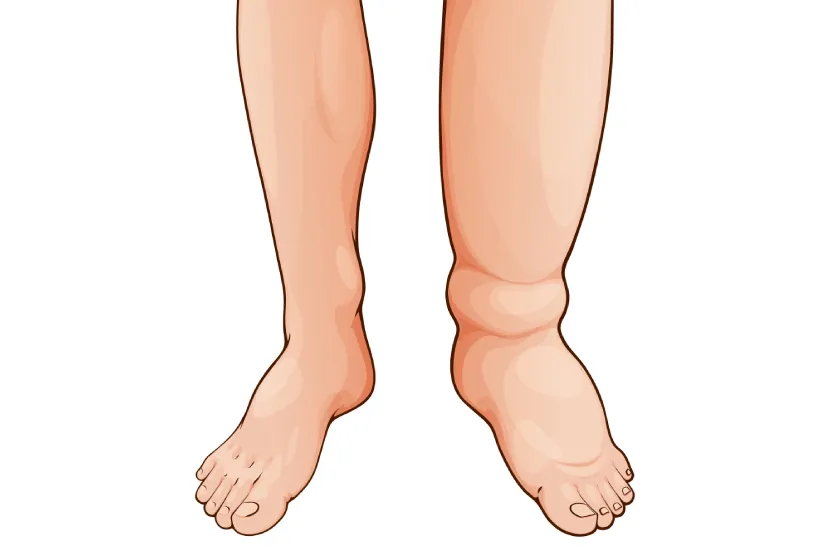
You step out of bed, and your feet feel heavy. Your ankles look puffier than usual. By evening, your legs seem to have doubled in size. Sound familiar? Swollen legs and feet are an uncomfortable reality for many people, especially those with sedentary lifestyles or medical conditions that affect circulation.
What’s surprising, however, is how often the solution lies in something as simple as water. Yes, the very thing you might be neglecting could be your best ally in relieving that uncomfortable swelling.
Before you pour yourself a glass, let’s dive deeper into what’s really going on in your legs and how hydration fits into the picture.
In this article, I aim to help you understand what Peripheral Vascular Disease is, what symptoms to watch out for, what causes it, and most importantly, how it can be treated effectively.
Understanding Swollen Legs and Feet
Swelling in the lower limbs, commonly referred to as peripheral edema, is usually caused by a buildup of excess fluid in the tissues. This can make your legs and feet look larger, feel tight, and sometimes even cause pain or a tingling sensation.
But not all swelling is the same. Some people experience it mildly after a long day, while others live with chronic discomfort that affects their daily life. In either case, the cause often points to one thing: fluid imbalance. When your body holds on to more fluid than it should, particularly in the lower parts due to gravity, it leads to what we call water retention in feet and legs.
So why does your body decide to trap this fluid in your legs? The answer lies in the causes of water retention.
What Causes Water Retention in Legs?
Water retention happens when the body holds on to more fluid than it needs. Normally, our kidneys, heart, and blood vessels work in sync to maintain a healthy balance. But certain triggers throw this off balance and cause fluid to leak into surrounding tissues, especially in the legs, where gravity has the strongest pull.
The most common swollen legs include:
- Poor circulation, especially due to weakened veins and weak calf muscles.
- Long periods of sitting or standing
- High salt intake, which encourages fluid retention
- Hormonal fluctuations or certain medications
- Underlying health conditions such as kidney disease, heart issues, or liver problems
It’s important to understand that swelling is a symptom, not a diagnosis. But when it’s related to water retention in legs, your first line of defense might be simpler than you think, starting with what you drink.
How Drinking Water Helps with Swollen Legs
Here’s where things get interesting. Many people assume that drinking more water would make swelling worse, but the opposite is true. In fact, dehydration can cause your body to cling to every drop of fluid it has, increasing water retention in feet and legs.
Hydration supports the body in more ways than one. Drinking enough water helps flush out excess salt, a key player in fluid retention. It also keeps your blood flowing smoothly, reducing the likelihood of fluid pooling in the lower limbs.
Let’s take a closer look at how water works behind the scenes:
It flushes out sodium: When you drink more water, your kidneys are better equipped to remove excess sodium through urine. Since high sodium is a major cause of water retention in the legs, this step alone can bring noticeable relief.
It reduces your body’s urge to retain fluids: When you’re dehydrated, your body holds on to water as a protective measure. But if you’re consistently well-hydrated, the body feels safe to release unnecessary fluid.
It supports healthy circulation: Water helps maintain proper blood viscosity, which means better circulation. Improved blood flow reduces the risk of fluid buildup in your legs and feet.
So, the next time your legs feel heavy, instead of reaching for painkillers, start with a glass of water.
Additional Tips for Relief from Swollen Legs
While drinking water is essential, combining it with a few lifestyle changes can multiply the benefits. If you’re struggling with persistent leg swelling, here are a few effective strategies to complement your hydration habits:
- Elevate your legs regularly. Elevating your feet above heart level for 15-20 minutes helps fluid move back toward your upper body, relieving pressure from the legs.
- Limit your salt intake. Salt attracts and holds onto water, contributing to water retention in feet. Switch to low-sodium alternatives and reduce processed foods.
- Get moving. Regular leg movements encourage blood and lymphatic flow. Even simple exercises like ankle circles or walking can prevent fluid from pooling. The role of calf muscle pump is crucial in helping the return of venous blood back towards the heart.
- Use compression garments. Medical-grade compression stockings help push fluid out of the legs and reduce swelling, especially if your job requires sitting or standing for long hours.
- Watch your water sources. Herbal teas such as dandelion or parsley tea have mild diuretic properties and can support fluid balance naturally.
But what if these methods aren’t enough? When leg swelling becomes frequent, painful, or affects one leg more than the other, it could signal a more serious condition.
Best Treatment for Swollen Legs: When to See a Doctor
Not all cases of swelling can be managed at home. Sometimes, swollen legs are the body’s way of telling you there’s a deeper issue, like chronic venous insufficiency, deep vein thrombosis (DVT), or lymphatic problems.
You should see a specialist if you experience:
- Persistent or worsening swelling
- Pain, warmth, or redness in one leg
- Swelling that doesn’t improve with elevation
- Skin changes, discoloration, or non-healing wounds
- Swelling associated with breathlessness or chest pain
In such cases, medical intervention is crucial. And if you’re in India, there’s one name patients trust when it comes to leg swelling and vascular health.
Why Consult Dr. Sumit Kapadia for Chronic Swelling
As a vascular and endovascular surgeon, I’ve seen how chronic leg swelling can silently affect a person’s daily life — from discomfort and heaviness to reduced mobility and confidence. Over the years, I’ve treated thousands of patients dealing with water retention in the legs, varicose veins, lymphatic issues, and other underlying causes of persistent swelling.
At my clinic in Vadodara, I believe in looking beyond temporary fixes. I begin with a detailed evaluation, often supported by advanced imaging like venous Doppler studies, to identify the exact cause of your symptoms. Whether your swelling stems from superficial vein damage, deep vein reflux, or lymphatic dysfunction, my goal is to provide a comprehensive treatment plan — one that is personalized, effective, and minimally invasive whenever possible.
From laser procedures to compression therapy, lifestyle advice to surgical interventions, each solution is designed to offer not just relief, but lasting results. If your swelling is ongoing or worsening, don’t wait. With the right diagnosis and approach, real relief is possible — and I’m here to help you find it.
Conclusion
Swelling in the legs and feet is not just a surface-level concern. It often points to how your body is managing circulation, salt balance, and overall fluid retention. What many don’t realize is that something as simple as drinking enough water each day can make a noticeable difference.
Proper hydration helps reduce excess sodium in your system, supports better blood flow, and prevents your body from unnecessarily retaining fluids. It’s one of the easiest first steps you can take toward finding relief from swollen legs.
But I also understand that not all swelling is simple. If you’ve tried home remedies and still struggle with discomfort, it may be time to evaluate what’s happening beneath the surface. Chronic leg swelling could be your body’s signal that it needs medical attention — and that’s where my expertise as a vascular specialist comes in.
Remember, your legs carry the weight of your day. Don’t ignore what they’re trying to tell you. Start with hydration, stay active, and if the swelling persists, reach out for professional care. You don’t have to live with the discomfort — we can work together to find the right solution.
Frequently Asked Questions (FAQs)
Yes. Drinking enough water helps flush out excess salt and reduces the body’s tendency to retain fluid, which in turn can ease leg swelling.
Absolutely. Dehydration can trigger your body to hold onto water, leading to fluid accumulation in the feet and legs.
This could be due to poor circulation, varicose veins, or fluid retention. If it persists or affects only one leg, consult a vascular specialist.
Elevate your legs, reduce salt intake, wear compression stockings, hydrate, and move around often. If swelling continues, seek medical advice.
Water is the best. Herbal teas with natural diuretic effects, like dandelion or green tea, may also help reduce water retention in the feet.

Dr. Sumit Kapadia
MBBS, MS, MRCS, DNB-Fellow



